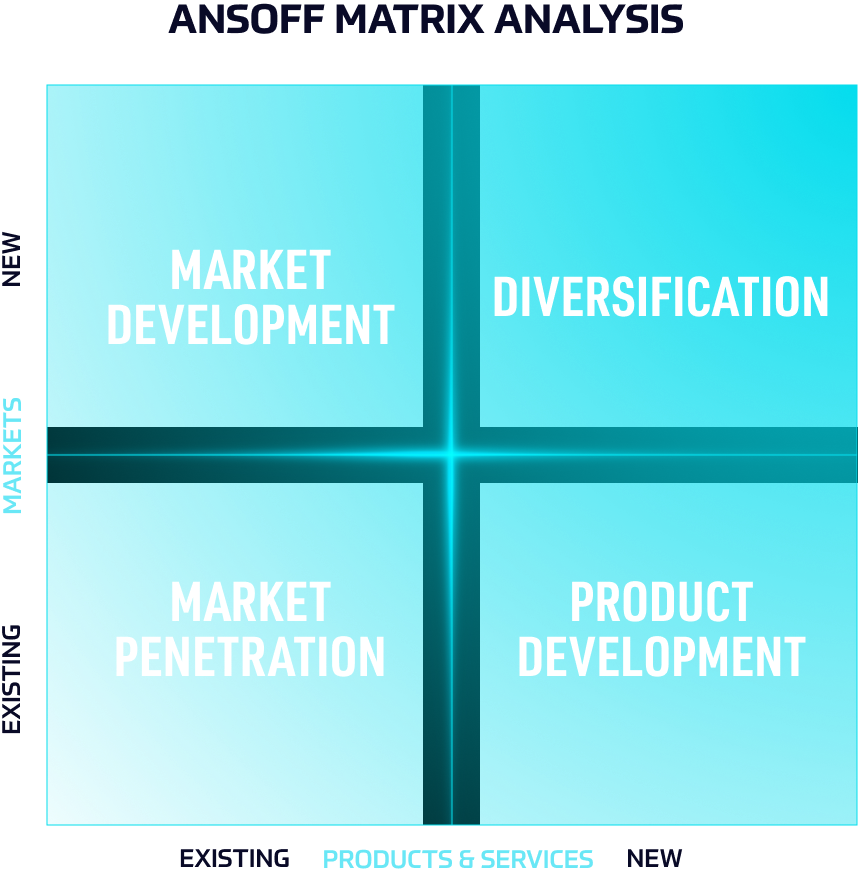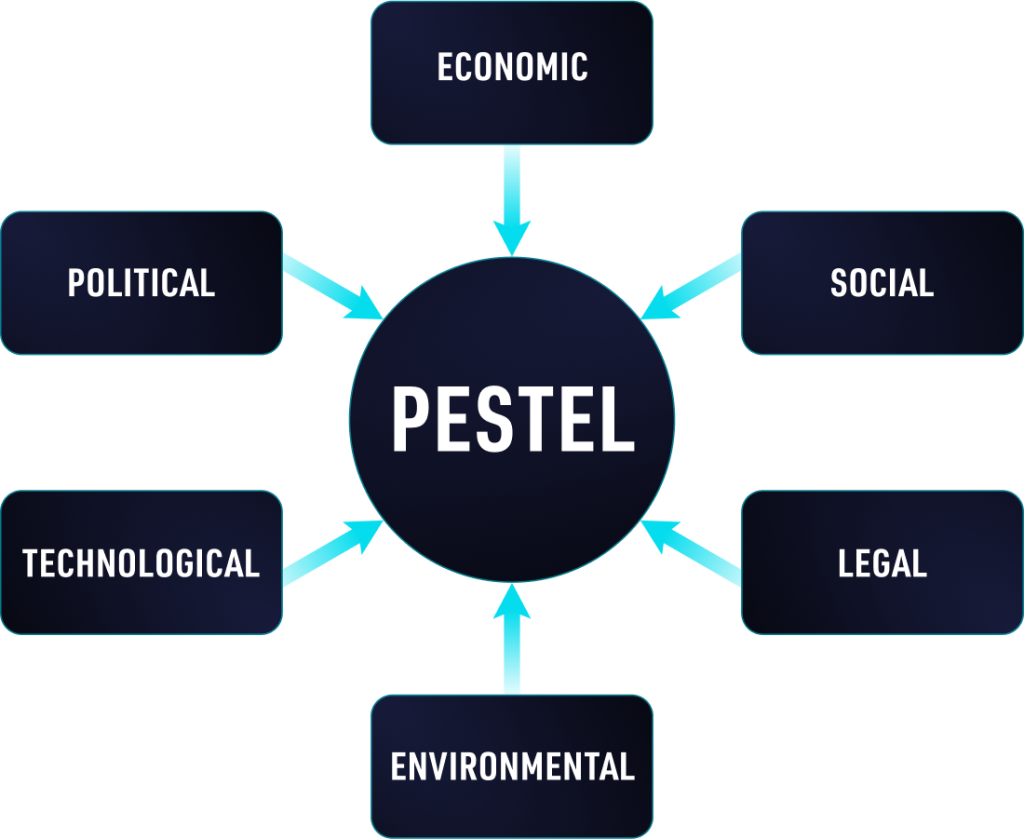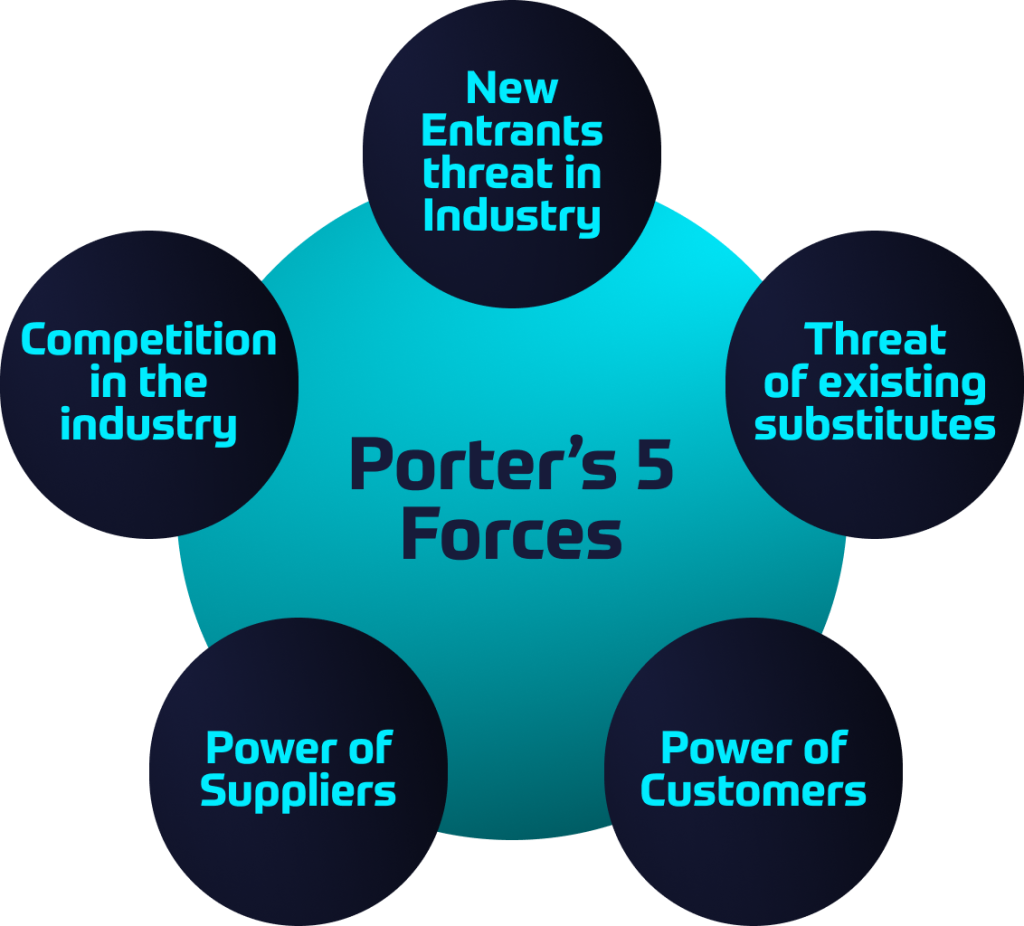5 business strategy frameworks for business growth

How to grow your business with 1 strategy framework
Business Strategy Framework #1 ANSOFF MATRIX ANALYSIS
The Ansoff Matrix is a business strategy framework and a planning tool that provides managers with a template to devise strategies for future growth.

There are 4 growth strategies within the Ansoff Matrix:
- Market penetration strategy = in which the company seeks to improve business performance either; by increasing the volume of sales to its present customers or by finding new customers for present products;
- Market development strategy = in which the company sells its existing products to new markets;
- Product development strategy = in which the company develops new products for the same market;
- Diversification strategy = in which the company develops new products in a new market.
What growth strategies does Apple use?
Learn from our Ansoff Matris analysis of Apple.
Business Strategy Framework #2 BCG GROWTH-SHARE MATRIX
The BCG Growth-Share Matrix helps companies analyze their business units (i.e. their product lines) or any other cash-generating entities by their degree of profitability.
This business strategy framework provides the company with a four-quadrant chart where products are ranked on the basis of their relative market shares and growth rates:
“cash cows”,
“dogs”,
“question marks” and
“stars”.

Cash cows are products in low-growth areas for which the company has a high market share.
Products with a low market share in areas with slow growth are dogs.
Question marks are the products with a low market share in a high growth rate market.
Stars are products with a high market share in a high growth rate market.
To show how you can use the matrix for your business, read our analysis of e-commerce leader Amazon, specifically four of its products: Amazon AWS, Amazon Video, Amazon Live and Amazon Echo with Alexa.
Business Strategy Framework #3 PORTER DIAMOND MODEL
The Porter Diamond Model is a business framework that describes a nation’s competitive advantage in the international market.
It also refers to innovation and why certain companies based in certain nations are capable of consistent innovation.

The 4 attributes of the Porter’s Diamond Model:
Factor Conditions = defines the nation’s position in factors of production, such as labour, land, natural resources, capital or infrastructure, necessary to compete in a given industry.
Demand Conditions = refers to the nature of home-market demand for the industry’s product or service.
Related and Supporting Industries = reveals the presence or absence in the nation of supplier industries and other related industries that are internationally competitive.
Firm Strategy, Structure, and Rivalry = highlights the conditions in the nation governing how companies are created, organized, and managed, as well as the nature of domestic rivalry.
Curious to see Porter’s Diamond Model applied to two leading brands?
Read Porter’s Diamond Model Analysis – Louis Vuitton and BMW.
Business Strategy Framework #4 PESTEL
PESTEL business analysis is a framework for helping entrepreneurs and business people to understand the impact of macro-environmental factors on their businesses.
The PESTEL acronym stands for 6 factors: POLITICAL, ECONOMIC, SOCIAL, TECHNOLOGICAL, ENVIRONMENTAL, and LEGAL.

Political factor = helps you appraise the degree to which a government intervenes in the economy or a certain industry.
Economic factor = examines the economic growth, exchange rates, interest rates, unemployment rates, the state of the country’s infrastructure, and taxes.
Social factor = analyzes the profile and behaviour patterns of your customers.
Technological factor = lists the technologies impacting your industry and whether they are or not favourable.
Environmental factor = takes into account any negative impact your company operations have on the environment and prompts your company to reduce the carbon footprint, reduce waste and pollution, and preserve the environment.
Legal factor = looks into the laws and regulations of your industry.
Not sure how to apply the framework to your business?
Read A Pestel Analysis of Nike.
Business Strategy Framework #5 PORTER’S 5 FORCES
Porter’s 5 Forces framework is a valuable business tool that helps entrepreneurs shape their strategy to drive profitability.

Porter’s 5 forces are:
1. Existing rivals = Evaluate the existing rivals by looking at the number of competitors, their size and power, the industry growth rate and product differentiation.
2. Buyers = The buyers are powerful and can influence the industry if they make purchases in large volumes. Are they price-sensitive? Do they have many alternatives to buy from?
3. Suppliers = Factors in determining supplier power: number of suppliers and concentration, switching costs, availability of substitutes, uniqueness of product, whether or not the industry is an important customer of the supplier and its availability to cut out the middleman.
4. Substitutes = Substitutes are alternative products that fulfil the same need by different means. In the airline industry, the substitutes are trains and cars.
5. New rivals = Is it easy for new rivals to enter the industry? If the entry barrier is low, which means requirements to enter the industry are affordable or readily accessible, then there are increasing chances of new entrants in great numbers. In this case, the threat is high.
Join BRAND MINDS 2023 and learn strategic business moves to uncover new markets from Bestselling Author of Blue Ocean Strategy Renée Mauborgne.

What growth strategies does Apple use? An Ansoff Matrix analysis
What growth strategies does Apple use? Let’s find out by applying the Ansoff Matrix framework.
What is the Ansoff Matrix?
The Ansoff Matrix is a strategic planning tool that provides a framework to help executives and managers devise strategies for future growth.
Also called the Product/Market Expansion Grid, the Ansoff Matrix is a method for measuring the profit potential of alternative product-market strategies.
There are 4 growth strategies within the Ansoff Matrix:
- market penetration,
- market development,
- product development,
- diversification.
What growth strategies does Apple use?
In 2018, the 45-year-old tech giant became the first US company to hit the $1 trillion milestone.
Last year, Apple surpassed it when the company registered a new record: a $2 trillion valuation on the stock market.
Let’s see how Apple is growing according to the Ansoff Matrix.

Join BRAND MINDS 2023.
Ansoff Matrix for Apple – Market penetration
Market penetration is about increasing sales.
Thanks to the iPhone, Apple’s core product, the company has ranked among the Top five smartphone vendors in the world since 2009.
Apple’s main strategy for increasing iPhone sales every year is a combination of pricing strategy, product innovation and community leveraging.
Apple has been growing a strong community of die-hard passionate fans since the early 1980s when Guy Kawasaki became the brand’s chief evangelist.
He was the first to understand how valuable an engaged community is for the brand. Through his EvangeList, a mailing list that brought together all Apple fans around the world, he managed to influence and inspire the Apple community with the purpose to support and defend Apple’s products and brand image.
When Apple launches a new iPhone model every year, these fans are the first customers to purchase the product. They are the early adopters, fully dedicated to the brand. To the rest of the world, the launch price of a new iPhone might seem very high. iPhone fans see a different story, one of emotional engagement, excitement and the feeling of participating in a historical event. Owning an iPhone also makes a statement about you as an individual.
When a new iPhone is launched, the previous model decreases in price thus driving a continuous flow of new and old smartphone sales.
Ansoff Matrix for Apple – Market development
Market development is about selling existing products in new markets.
The latest figures from market research showed that the iPhone 11 was the most popular model of all smartphone brands sold on the Chinese market in 2020 (source). China is Apple’s second largest market following the US.
How did Apple expand its business to China?
Apple entered the Chinese smartphone market in 2010. Within five years, Apple’s sales in the region grew more than 20-fold (source).
What was behind Apple’s amazing success in China?
Great timing!
Apple began tapping into the Chinese market around the time the country’s economy was seeing a resurgence due to the rising world demand for consumer electronics.
The Chinese urban middle class was beginning to form. And they had money to spend. The iPhone was one of the consumer goods they could now afford to buy as a symbol of wealth and status.
In recent years, with the rise of strong competition from Huawei and Samsung, sales in China have been stalling.
It’s time for Apple to expand into a new country and India has shown increased demand for Apple products through the company’s third-party partners.
CEO Tim Cook announced last year that the tech giant would be opening its first flagship store in India by the end of 2021.
Ansoff Matrix for Apple – Product development
Product development is about developing new products in the same market.
How much does Apple invest in research and development?
Apple Inc. spent a record $18.75 billion on research and development in its 2020 fiscal year, increasing by about $2.5 billion from its 2019 total (Statista). It’s more than Samsung ($18.6 billion) but less than Huawei ($20 billion), Apple’s main competitor.
Looking outside the smartphone industry, to the tech companies that make up the Big Five list, Apple is yet again not the biggest spender on R&D: in 2020, Amazon spent $42 billion and Google, $27 billion.
Apple has been launching new products in every one of its product lines every year since the company’s foundation four decades ago.
Apple I, the first personal computer created by Steve Jobs and Steve Wozniak in 1977 was not the first personal computer ever to be commercialized on the market.
Four years earlier, Xerox had launched Xerox Alto. The Alto had innovative features like a graphical user interface (GUI), a mouse, large internal and external memory storage and specific software.
Yet the launch of Apple’s computer marks the beginning of the personal computer industry.
MacBook Air, Apple’s latest laptop launched in the Fall of 2020 currently ranks at #1 in the top 3 best laptops in the world.
Apple has set out to make only great products by constantly focusing on innovating.
Ansoff Matrix for Apple – Diversification
Diversification is about developing new products in a new market.
Apple began diversification early on.
Throughout its history, the company has produced a wide range of products like drives, printers, modems, displays and gaming consoles which were later discontinued.
Starting with 2001, Apple has developed innovative product lines like the iPod (2001), the iPhone (2007), the iPad (2010), the AppleWatch (2015) and the smart speaker HomePod (2018).
What makes Apple so prolific and innovative?
Its strategic approach to R & D. Apple doesn’t innovate to be the first; it innovates to be the best.
The iPhone was not the first smartphone on the market when it launched in 2007. There were smartphones manufactured by brands like Nokia, Samsung, Sony Ericsson and Motorola. Yet, the iPhone set a new standard in the industry and quickly became a trendsetter.
It all comes back to not being the first, but being the best.
Here’s what Apple CEO Tim Cook said in an interview in 2015 regarding how the company decides what new products to develop next:
When Apple looks at what categories to enter, we ask these kinds of questions: What are the primary technologies behind this? What do we bring? Can we make a significant contribution to society with this? If we can’t, and if we can’t own the key technologies, we don’t do it.
What is Apple going to make next?
As different as the current product lines are, they belong to the same market: consumer electronics. They are, as the experts say, related diversification.
Over the past year, rumours have been circulating about Apple going outside its main market, in an unrelated diversification effort and building a car, more specifically, a self-driving electric vehicle.
In a market dominated by Tesla, what would the Apple Car look like?
What innovation will the car bring into the market?
What significant contribution to society will the Apple Car make?
We don’t know yet.
But if we are to believe Mr Cook’s statement, it should be big enough to blow the competition out of the water.
Join the Conversation
We’d love to hear what you have to say.
Get in touch with us on our LinkedIn Page, Facebook Page, Twitter or TikTok.
Ansoff Matrix allows you to plan your company’s growth
Looking to plan your company’s growth and don’t know which way to go? Use the Ansoff Matrix to opt for the right growth strategy for your business!
- What is the Ansoff Matrix useful?
- What are Ansoff Matrix’s 4 growth strategies?
- Who created the Ansoff Matrix?
- Why is the Ansoff Matrix useful?
What is the Ansoff Matrix?
The Ansoff Matrix is a strategic planning tool that provides a framework to help executives and managers devise strategies for future growth.
What are Ansoff Matrix’s 4 growth strategies?
The Ansoff Matrix also called the Product/Market Expansion Grid, is a method for measuring the profit potential of alternative product-market strategies.
Here are the 4 growth strategies: market penetration, market development, product development, diversification.
The Ansoff Matrix – Market penetration
Market penetration is an effort to increase company sales without departing from an original
product-market strategy.
The company seeks to improve business performance either by increasing the volume of sales to its present customers or by finding new customers for present products.
This growth strategy presents the least risk to a company because it focuses on existing products in existing markets.
The Ansoff Matrix – Market development
Market development is a strategy in which the company attempts to adapt its present product line (generally with some modification in the product characteristics) to new missions.
The market development growth strategy is somewhat less risky since it refers to existing products in new markets.
The Ansoff Matrix – Product development
A product development strategy, on the other hand, retains the present mission and develops
products that have new and different characteristics. These products will improve the performance of the mission.
This growth strategy is not as risky as diversification because it is easier to develop new products in a market the company already has.
The Ansoff Matrix – Diversification
Diversification is the fourth growth strategy and the riskiest. It calls for a simultaneous departure from the present product line and the present market structure.
Developing new products in new markets requires extensive research conducted by the company: market research, customer research, buying behaviour analysis, external influences on the market, business environment analysis etc.
A healthy company can take any of the above growth strategy paths to survive and thrive.
Or it can choose to pursue three of them simultaneously: market penetration, market development and product development.
Diversification is the most difficult growth strategy a company can implement.
While the other three require the same technical, financial and operational resources used for the original product line, diversification requires a distinct break with past business practices.
New skills, new technologies, new resources are needed in order to diversify. Diversification basically means starting a new business which entails organizational changes and other unforeseen challenges that management needs to address.
Two types of diversification
There are two types of diversification: related diversification and unrelated diversification.
In related diversification, the company develops a new line of products but remains in the same industry.
Toyota Company is a car manufacturer and a humanoid robots developer. The company has the knowledge and the resources in place (automated assembly lines) to develop both lines of products.
In unrelated diversification, the company develops products that are outside its original industry.
A good example is Tesla, the leading electric car manufacturer, which moved into spirits with the launch of Tesla Tequila, an exclusive, premium beverage.
Who created the Ansoff Matrix?
The tool was developed by Igor Ansoff known as the father of Strategic management.
Igor Ansoff was an applied mathematician and business manager who worked at Lockheed Aircraft Corporation where he became Vice President of Planning and Director of Diversification.
Following his tenure at Lockheed, Igor went into academia and was a Professor of Management at Owen Graduate School of Management.
In 1983 he joined the U.S. International University (USIU, now Alliant International University) where he created the school’s strategic management program.
He has consulted with hundreds of multinational corporations including, Philips, General Electric, and IBM.
To honour his body of work, the prestigious Igor Ansoff Award was established in 1981 in the Netherlands. The award is given for research and management in the study of Strategic Planning and Management.
Igor first described the matrix in Strategies for diversification, an article published in 1957 in the Harvard Business Review. The strategic planning tool was subsequently published by Igor in his book Corporate Strategy: An Analytic Approach to Business Policy for Growth and Expansion (1965).
Why is the Ansoff Matrix useful?
The Ansoff Matrix is a highly useful strategic tool that allows executives, business developers and managers to make the right decision for the company growth-wise.
Here are the benefits of using the Ansoff Matrix:
- It helps executives analyse the risk involved while moving in a particular direction;
- It provides managers with a clear map of possible strategies for growth;
- This tool provides different options that managers can go with according to two variables: products and market;
- It helps marketers determine marketing strategies, planning activities and opportunity costs.
Sources: Strategies of Diversification (1957), AnsoffMatrix.com
Join the Conversation
We’d love to hear what you have to say.
Get in touch with us on our LinkedIn Page, Facebook Page, Twitter or TikTok.










